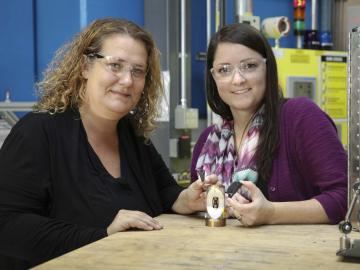
Filter News
Area of Research
- (-) Energy Science (95)
- (-) Materials Under Extremes (1)
- Advanced Manufacturing (9)
- Biological Systems (2)
- Biology and Environment (102)
- Biology and Soft Matter (1)
- Computational Biology (2)
- Computational Engineering (3)
- Computer Science (7)
- Electricity and Smart Grid (1)
- Fuel Cycle Science and Technology (1)
- Functional Materials for Energy (1)
- Fusion and Fission (48)
- Fusion Energy (18)
- Isotope Development and Production (1)
- Isotopes (12)
- Materials (126)
- Materials Characterization (1)
- Materials for Computing (18)
- Mathematics (1)
- National Security (31)
- Neutron Science (128)
- Nuclear Science and Technology (43)
- Nuclear Systems Modeling, Simulation and Validation (2)
- Quantum information Science (1)
- Sensors and Controls (1)
- Supercomputing (89)
- Transportation Systems (1)
News Topics
- (-) Advanced Reactors (6)
- (-) Artificial Intelligence (8)
- (-) Bioenergy (26)
- (-) Biomedical (6)
- (-) Fusion (1)
- (-) Materials Science (27)
- (-) Neutron Science (11)
- (-) Nuclear Energy (7)
- (-) Security (6)
- 3-D Printing/Advanced Manufacturing (79)
- Big Data (5)
- Biology (11)
- Biotechnology (4)
- Buildings (38)
- Chemical Sciences (14)
- Clean Water (8)
- Composites (17)
- Computer Science (25)
- Coronavirus (12)
- Critical Materials (9)
- Cybersecurity (8)
- Energy Storage (71)
- Environment (54)
- Exascale Computing (2)
- Fossil Energy (2)
- Frontier (2)
- Grid (39)
- High-Performance Computing (6)
- Hydropower (3)
- Isotopes (1)
- Machine Learning (7)
- Materials (36)
- Mathematics (2)
- Mercury (3)
- Microelectronics (1)
- Microscopy (8)
- Molten Salt (1)
- Nanotechnology (8)
- National Security (5)
- Partnerships (12)
- Physics (1)
- Polymers (11)
- Quantum Science (2)
- Simulation (4)
- Space Exploration (3)
- Statistics (1)
- Summit (4)
- Transportation (66)
Media Contacts

Oak Ridge National Laboratory scientists seeking the source of charge loss in lithium-ion batteries demonstrated that coupling a thin-film cathode with a solid electrolyte is a rapid way to determine the root cause.

Ada Sedova’s journey to Oak Ridge National Laboratory has taken her on the path from pre-med studies in college to an accelerated graduate career in mathematics and biophysics and now to the intersection of computational science and biology

The Department of Energy’s Office of Science has selected three Oak Ridge National Laboratory scientists for Early Career Research Program awards.

Oak Ridge National Laboratory has licensed a novel method to 3D print components used in neutron instruments for scientific research to the ExOne Company, a leading maker of binder jet 3D printing technology.

Giri Prakash, data informatics scientist and director of the Department of Energy’s Atmospheric Radiation Measurement Data Center at Oak Ridge National Laboratory, has accepted an invitation from the National Academies of Sciences, Engineering, and Medicine to serve a four-year term on the U.S. National Committee for CODATA.
An international team of scientists found that rules governing plant growth hold true even at the edges of the world in the Arctic tundra.

Oak Ridge National Laboratory researchers have developed a thin film, highly conductive solid-state electrolyte made of a polymer and ceramic-based composite for lithium metal batteries.

Researchers at the Department of Energy’s Oak Ridge National Laboratory are refining their design of a 3D-printed nuclear reactor core, scaling up the additive manufacturing process necessary to build it, and developing methods

Scientists at the Department of Energy’s Oak Ridge National Laboratory have developed a new method to peer deep into the nanostructure of biomaterials without damaging the sample. This novel technique can confirm structural features in starch, a carbohydrate important in biofuel production.

Each year, approximately 6 billion gallons of fuel are wasted as vehicles wait at stop lights or sit in dense traffic with engines idling, according to US Department of Energy estimates.


